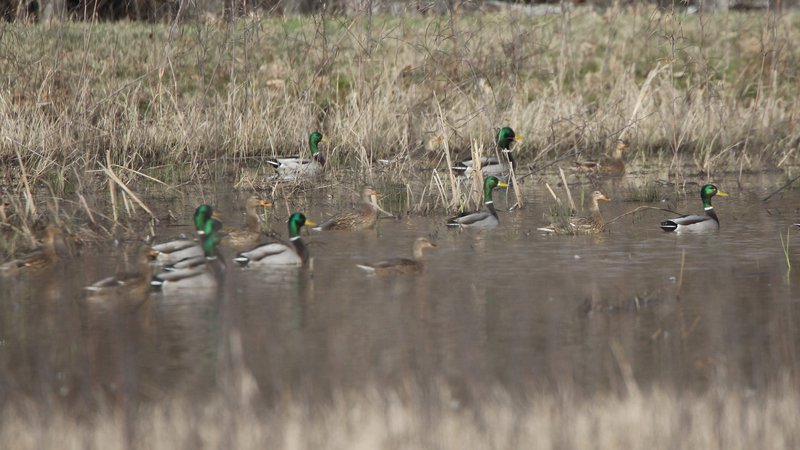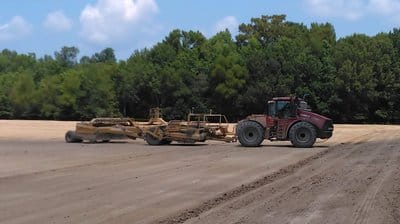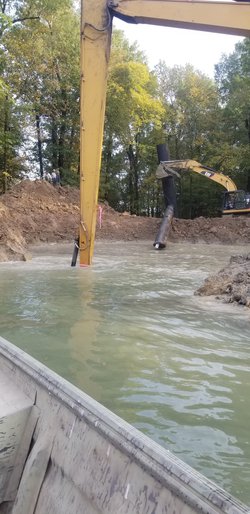AGFC, Ducks Unlimited cook up new recipe for duck food at Dave Donaldson Black River WMA
ON 09-29-2021

Sept. 29, 2021
Randy Zellers
Assistant Chief of Communications
POCAHONTAS — The Arkansas Game and Fish Commission and Ducks Unlimited recently put the finishing touches on a two-year renovation project at the Brookings Moist Soil Unit within Dave Donaldson Black River Wildlife Management Area in Northeast Arkansas. The project promises to substantially increase the amount of food able to be produced for waterfowl in the 151-acre complex of managed native vegetation.
The Brookings Moist-Soil Unit complex is a specially managed portion of the WMA reserved as a rest area for ducks, offering them food without pressure and a reason to stay on and around the WMA instead of moving on during their migration.

Last year, contractors buried thousands of feet of pipe to improve water delivery throughout the moist-soil units and placed a new relift pump in the Black River to offer a more reliable and efficient year-round water source. This year’s work focused on constructing and moving levees to better manage the flow of water through the system to flood it when needed and remove it quickly when the time comes to dry things out.
Much of the funding for the Brookings project came from a $1 million North American Wetlands Conservation Act grant, a competitive grant from the U.S. Fish and Wildlife Service. But for every dollar given, the state must contribute a dollar from nonfederal sources. Ducks Unlimited stepped in to help carry the load. DU helped write and administer the grant and brought along matching contributions, both financially and with in-kind donations of land and labor to complete the package needed to receive the grant. A portion of the grant also was used to purchase a 40-acre inholding at Bayou DeView and fund a waterfowl-habitat project on Dale Bumpers White River National Wildlife Refuge.

According to Jason “Buck” Jackson, statewide wetland program coordinator for the AGFC, moist-soil management essentially is farming for select native plants. These wetland grasses and forbs offer abundant food for waterfowl and are more reliable than agricultural crops, which can be prone to setbacks from disease and infestation by insects and other pests. But creating moist-soil habitat is much more than sitting back and watching the grass grow. It still requires hard work and precise water control to maximize the benefit for waterfowl.
“Managing for moist-soil plants requires you to manipulate vegetation with cleated rollers to reduce competition and promote germination of beneficial plant seeds in the seed bank,” Jackson said. “It also requires precise management of water levels throughout the year to promote good, seed-producing plants,” Jason “Buck” Jackson, said.
According to Jackson, annual smartweeds, wild millets, toothcup, and other moist-soil plants need wet conditions in spring to get started, but then need to be treated like a row crop and irrigated every couple of weeks to increase their growth and yield. Then when the grasses begin to put out seed, the area can be mechanically manipulated for invertebrate production prior to its fall flooding to make the seed available for waterfowl and increase habitat.

“Dave Donaldson already has a lot of agricultural land nearby to offer waste grain when it’s around,” Jackson said. “Lake Ashbaugh offers loafing areas and the flooded hardwoods in the greentree reservoir offer shelter, acorns and invertebrates, the moist-soil units offer different foods that the ducks need, too. Each component is a piece of the puzzle to make this place a duck magnet during their migration.”
The moist-soil units have been in place at Dave Donaldson for years, but Jackson says the latest renovations will help land managers find another gear in producing duck food.
“With the lower amount of flooded agricultural land on the landscape, earlier varieties of rice maturing well before duck season and modern equipment and techniques leaving less waste grain than ever before, high-energy food is at a premium,” Jackson said. “Well-managed moist soil can really help bridge that gap.”
According to research conducted by Luke Naylor, waterfowl program coordinator for the AGFC during his post-graduate work, properly managed moist-soil units can produce nearly double the food resources for ducks with the right planning and infrastructure. And Jackson is confident the new improvements at Brookings will offer those results.
“More food means more ducks and more ducks means happy hunters,” Jackson said.
Dave Donaldson Black River WMA near Pocahontas embodies the public green timber duck hunting Arkansas is known for. This 25,482 bottomland hardwood complex is surrounded by a sea of agricultural land that has attracted millions of ducks for decades.
Recent News

Baiting wildlife illegal on Lake Conway
Nov. 22, 2024
Subscribe to Our Weekly Newsletter E-mails
Don’t miss another issue. Sign up now to receive the AGFC Wildlife Weekly Newsletter in your mailbox every Wednesday afternoon (Waterfowl Reports are published weekly during waterfowl season and periodically outside the season). Fishing Reports arrive on Thursdays. Fill in the following fields and hit submit. Thanks, and welcome!

